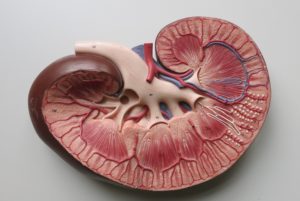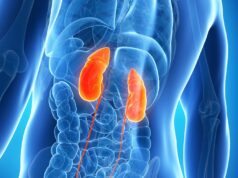
The “overwhelming majority” of previously-rejected deceased donor kidneys that have later been used for transplantation have been found viable by a new study published in Transplantation. According to its authors, the results suggest that more consideration should be given to high-risk donors for use in selected patients in need of a kidney transplant. The study focused on kidneys that were specifically rejected for donor or organ related reasons (DORR).
Kidney transplantation has been found in numerous studies to be a more effective long-term procedure for kidney disease than dialysis in terms of both survival and quality of life, yet “there are concerns that some kidneys are discarded unnecessarily” each year by patients and clinicians who deem some to be high-risk. The uncertainty underpinning the decision of clinicians to reject some donor kidneys has previously been explored by David Howard (Emory University, Atlanta, USA) et al, while analytics-based solutions have been proposed by Dimitris Bertsimas (Massachusetts Institute of Technology, Cambridge, USA) et al for easing it. But this study, led by Maria Ibrahim (Guy’s and St Thomas’ NHS Foundation Trust, London, UK), is the first outside of the USA to compare on a large scale the difference in outcomes between those who accept a higher-risk donor kidney and those who remain on the waiting list.
That distinction is crucial—the transplant community of the UK, where this study’s patients were enrolled, “implants kidneys from older, more marginal donors than the USA” while also offering chronic kidney disease (CKD) patients more kidneys from donation after circulatory death (DCD) donors. US kidney disease patients on the waitlist for a transplant reject a median of 16 offers, yet they have an eight-year cumulative mortality of 42%. UK patients, meanwhile, still reject over 40% of initial deceased donor kidney offers, but “the nation’s organ utilisation practices” remain “generally more aggressive than many other countries”. This makes it a particularly worthwhile site for comparing outcomes for those who remain on the waitlist with those who accept a kidney they perceive as suboptimal, such as those from aged donors or those with comorbidities.
In the UK, kidneys declined for a named patient are either offered to another or entered into the UK Kidney Fast Track Scheme (KFTS), which is run by NHS Blood and Transplant (NHSBT). The study was performed “within NHSBT as a service evaluation project to monitor the national transplant programme” and included kidneys offered to named patients over the age of 18. Kidneys that were finally deemed nonviable were excluded, with only those that were eventually used in a single-kidney transplant accepted. The kidneys came from donation after brain death (DBD) donors only. This study aimed to look at outcomes of both patients who declined deceased donor kidney offers and those who received the declined organ. Of patients who received a previously-rejected kidney, 1,718 were examined, while 2,805 patients who rejected a kidney and later received one were also included. Kidney quality was measured using the US Kidney Donor Risk Index (KDRI).
Outcomes for those implanted with a previously-rejected kidney included “all-cause graft failure, death-censored graft survival (DCGS), and patient survival at one and five years post-transplant”. At one year after their transplant, 91% remained alive with a functioning graft with 4% dying, while 81% survived with a functioning graft at five years. Survival outcomes for those who rejected a transplant and eventually received a later one were “comparable”, and “4% of patients were either removed from the list or died while on the [waiting] list”.
In their discussion, the authors are keen to stress the point that improved outcomes were not found for those who rejected a kidney “despite waiting for an additional 174 days, on average, before being transplanted”. Waiting for a “better” offer did not then, they say, improve patient or graft survival, while “there may well be a quality-of-life advantage associated with early transplantation for many patients”. Accepting rather than rejecting a kidney would at the very least offer “six months of dialysis-free patient survival” to those on the waiting list.
It is noted that such advantages may be more pronounced under the UK system of kidney allocation, whereas in countries like the USA, where waiting times are typically longer, “the morbidity and mortality associated with remaining on the list may well be higher”. The patients in the study who did receive a previously-rejected organ had also been on the waiting list a median of 10 months longer—suggesting “they were more willing to accept kidneys perceived to be of higher risk”.
The study stratified its results by centre, with 23 examined. Of those, four demonstrated a statistically significantly higher rate of organ refusals, echoing the “disparity in risk-appetite” found in studies in the USA. However, these centres did not ultimately show significantly different rates of functioning in the subsequent use of declined kidneys. Ibrahim et al argue that this suggested that these centres “are no better at discriminating between higher and lower quality kidneys” than others. They also remark that the similar survival of patients who rejected the deceased donor kidney offer and remained on the list compared to those who accepted a declined kidney marked a difference to US studies in the area, but that this may be explained by “longer waiting times for deceased donor kidney transplantation in the USA than in the UK” along with “comparatively higher rates of mortality on the list in the USA”.
The authors suggest that their study demonstrates a potentialissue of needlessly discarded kidneys as well as “unnecessary use of human resources” managing declined offers, though they also say it is important to note that each kidney offer required a highly individualised and complex decision-making process. They described too the “benefit of organ transplantation to the families of deceased donors” that is foregone when deceased donor kidneys are discarded. Existing risk stratification tools for patients and clinicians considering a transplant, meanwhile, are “not sufficiently accurate to inform patient-level decisions for organ acceptance or decline”, and organ-offering schemes need to be improved.
Patients were also included in the discussion. They needed “detailed education” on an “individualised” level, catered to those with various degrees of health literacy. The authors’ study itself, they suggest, may be useful in demonstrating that “selected kidneys can function well even when initially declined for donor- or organ-related reasons (DORRs)”.
Reviewing the study’s limitations, the authors point to the data’s lack of detailed explanation for each decline of an organ offer. It is also impossible to say, they add, whether the kidneys which eventually functioned well in one patient may have functioned equally as well in those who declined it. It was also difficult to find out what happened to patients after they were removed from the NHSBT list. “In addition,” they state, “as always, registry data cannot delve into the all-important quality of life advantages (or disadvantages) that may be involved in kidney transplantation.”
The issues around organ selection remain complex, Ibrahim et al conclude. Their study suggests the great majority of rejected kidneys declined for DORR in fact go on to be viable if used in transplantation, and “encourages the improved utilisation of organs perceived to be of higher risk”. It does, they say, remain important to nevertheless judge each case on its details.











